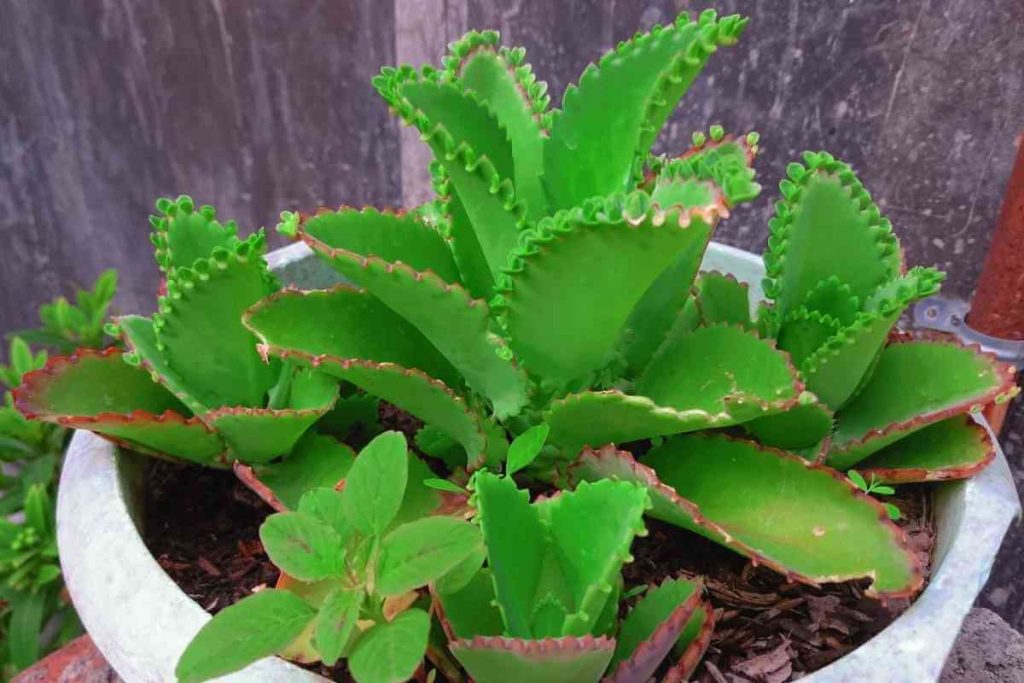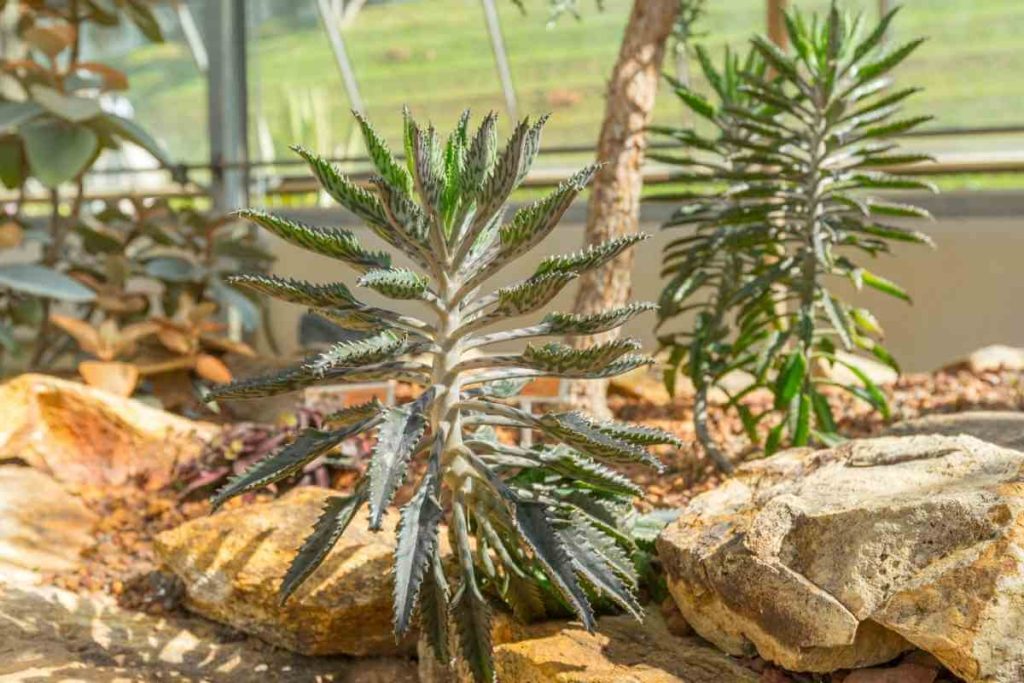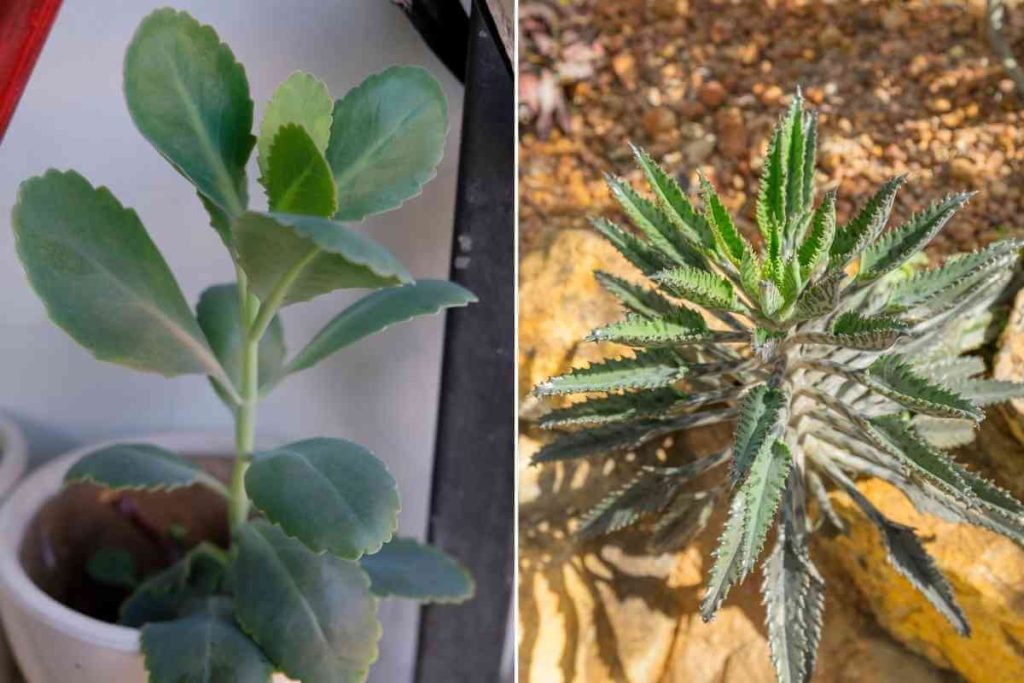Due to the similarities of their names, many people confuse the mother of millions with the mother of thousand plants. These two plants, however, are not the same. Looking at their leaves is the most straightforward way to tell them apart.
The Mother of Thousands (Kalanchoe daigremontiana) has large, tear-shaped leaves that grow in pairs opposite the stem. A 90-degree angle separates one pair from the other. This leaf development pattern ensures that one pair of leaves does not shade the other leaves. The plantlets grow in ridges in the mother of thousands’ leaves.
The Mother of Millions (Kalanchoe delagoensis), on the other hand, has narrow leaves. This succulent usually grows four leaves from the same node. The mother of millions’ plantlets only grows on the leaf tips. As a result, the plant produces fewer plantlets per leaf, often 2 to 5.
This article will compare mother of thousands vs mother of millions plants, outlining their key differences and similarities.
Table of Contents
What is Mother of Thousands Plant?
The Mother of Thousands plant, native to Madagascar, has incredible foliage.
When cultivated inside, this plant, also known as Kalanchoe daigremontiana, rarely blossoms. On the other hand, small plantlets form on the tips of the leaves, making this plant particularly fascinating.
The common name, ‘Mother of Thousands,’ originates from the extremely lovely baby plantlets that sprout along the edge of its enormous leaves. Mexican Hat Plant, Devil’s Backbone, and Alligator Plant are all names for this exceedingly strange plant.
Furthermore, these plantlets make propagation easier, which may surprise you even more. Kalanchoe, on the other hand, is a globally invasive species. As a result, gardeners believe that growing Mother of Thousands in containers is ideal.
The Mother of Thousands is one of the most drought-tolerant plants you’ll ever come across.
Mother of Thousands Plant Identification

It’s easy to figure out what it is. Large, blue, green leaves with sharp points can be found on mature stalks.
Aside from the Mother of Thousands’ lovely blossom, the succulent’s true beauty lies in its young plantlets. Interestingly, these young leaves fall from the succulents and take root where they land.
They will bloom in the late winter if they are maintained outside. However, when the mother plant dies after that, it leaves a large number of children to grow later.
What is the Mother of Millions Plant?
Kalanchoe delagoensis, or Mother of Millions, are fast-growing plants recognized for their quick multiplication wherever they grow.
This earns them the title of ‘Mother of Millions.’ Each mature plant produces several plantlets. The plantlets continue to grow indefinitely, and they can land on anything.
Although the plant can be plucked out, the seeds can last for many years. Drought-tolerant and adaptable, the plants thrive in a variety of environments. In other parts of the world, they are also considered weeds or even invasive species.
These gorgeous plants offer incredible features, are easy to care for, and proliferate quickly.
Mother of Millions Plant Identification

A fleshy herbaceous plant that grows 30-180 cm tall with upright (i.e., erect) stems. Its mottled leaves are boat-shaped and have several tiny teeth along their borders.
Along the edges of its leaves, tiny plantlets are frequently developed. It has drooping bell-shaped flowers that are bright red or reddish-pink in color and are 2-4 cm long. These blooms bloom in dense clusters at the tops of the plant’s stems.
Mother of Thousands Vs Mother of Millions
Below is a comparison table showing how the mother of thousands plants differs from the mother of millions!
| Mother of Thousands | Mother of Millions | |
| Common name | Mother of thousands, devil’s backbone, alligator plant. | Mother of Millions |
| Botanical name | Kalanchoe daigremontiana | Kalanchoe Delagoensis |
| Plant type | Succulents | Succulents |
| Family | Crassulaceae | Crassulaceae |
| Plant Origin | Native to southwestern Madagascar | Mother-of-millions are native to Madagascar |
| Mature Size | 3 ft. tall | Between 20″ to 28″ inches tall |
| Soil type | coarse sand to regular potting soil is okay. | Well-draining, sandy potting mix |
| Sun exposure | Full sun, partial shade | Full sun, partial shade |
| Toxicity | Every single part of the Mother of Thousands is toxic | Although the entire plant is poisonous, the blooms contain the most venom. |
| Cold Hardiness | It is hardy but cannot survive the winter. | It is very hardy and can grow all around the year. |
Differences Between Mother of Millions and Mother of Millions

The difference between Mother of Thousands and Mother of Millions in terms of care requirements is negligible.
Both species like to live on the drier side of life, with only a little direct sunlight. The genuine distinction is due to the morphology of the leaves and a minor variation in their toxicity.
Leaf Structure
The most significant difference is in the shape of their leaves. The leaves of Mother of Thousands are tear-shaped and wide.
They have a unique feature in that they grow in pairs. The leaves develop on the opposite sides of the stalk. The next pair rotates at a 90-degree angle, allowing fresh leaves to get sunlight.
At the leaf’s edges, there are little ridges. This is where the young plantlets are born. At the leaf edges, buds or plantlets grow. In the borders of a healthy leaf, there may be a complete supplement of babies.
There is a slender leaf on the Mother of Millions in various settings. It comprises four leaves that all grow in the same place along the stem, known as nodes.
There is nothing like what the mother of a Thousand does in terms of alternation. Plantlets grow from the tips of the leaves. Normally, each leaf has 2-4 babies.
Growth Behavior
Another distinction between the two mothers is their behavior during their development. A solitary center stalk grows towards the sun on Mother of Thousands. The leaves will fall over because of their weight, and growth will proceed.
The number of stalks that grow on the same plant is frequently in the millions. Its primary growth produces busk-like reinforcing.
How Often Should I Water Mother of Thousands Plants?
Mother of Thousands, like many succulents, prefers to dry out completely between watering.
With this plant, under-watering is preferable to over-watering, so be sure to let the soil dry completely between watering.
Because some plants aren’t as good as others at letting you know when they need water, use the weight of the pot to determine when they should be watered. If the pot seems heavy, it means that there is still water in the soil. It’s time to water if the pot is really light.
Always water your Mother of Thousands until there is water runoff. This indicates that every part of the soil is moist, and the plant will be able to drink as much as possible. Once it’s been watered, place the pot on a dry saucer and set it on the windowsill to dry out fully.
Frequently Asked Questions
How big does Mother of Millions get?
Mother of Millions is a single-stemmed, fast-growing upright plant. It usually stands between 20 and 28 inches tall, although it can grow up to 3 feet tall. The tubular leaves can range in length from 2 to 5 inches.
What is Mother of Thousands used for?
The Mother of Thousands is a medicinal plant that is used to prevent premature labor in pregnant women and to treat infertility.
Its use is not without risk, as the amount of the deadly steroid Daigremontianin present in the plant’s utilized leaves varies from plant to plant.
Is Mother of Millions invasive?
Both the Mother of Thousands and the Mother of Millions plants are considered invasive in many locations.
These plantlets are simple to uproot and remove, but their seeds can remain viable in the soil for years, resulting in new plants sprouting long after the original plants have been gone.
Can Mother of Thousands survive winter?
Although Mother of Thousands is resilient, it will not withstand a freeze. They prefer the sun and some shade, and if provided regular water, they can tolerate scorching weather.
How often should I water my Mother of Millions plant?
While drought-tolerant, these plants benefit from a drink several times a week during the warmer months of spring, summer, and occasionally fall. In the winter, they won’t require as much water, so be prepared to cut back.
Overwatering might cause this plant to droop and possibly drop its plantlets. If this occurs, stop watering it and allow it to dry out so that it can recover from the excess moisture.
Can Mother of Millions grow inside?
A well-draining, sandy potting mix is recommended for growing Mother of Millions as a houseplant.
It prefers direct sunlight; however, with 4-6 hours of bright sunlight every day, it may be cultivated indoors. Only water when the soil is dry, and the ideal growing conditions are 65-95°F (18-35°C).
Does Mother of Millions like humidity?
This isn’t necessary, but a little hose down now and again will hydrate the leaves and wash away any dust or pests.
Conclusion
The Mother of Thousands and Mother of Millions Plants are undoubtedly divisive. Some gardeners are enamored with it and want to grow more in their homes and gardens. Others are looking for a way to get rid of it from their lawn and yard.
Even with all of the drama that this plant brings to the gardening world, it is still a marvel to behold, and it is possible that the combination of drama, controversy, and wonder will make this succulent the next big thing in your life.




